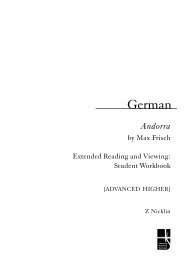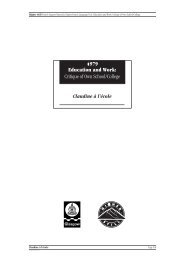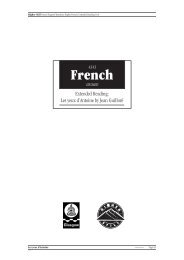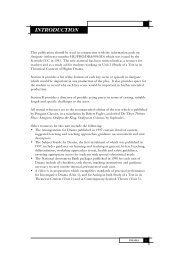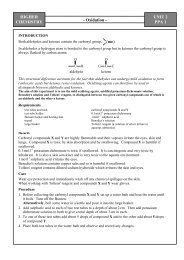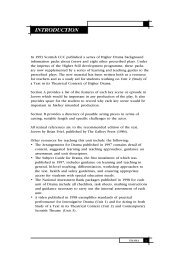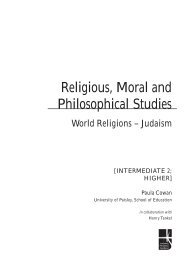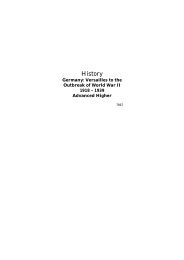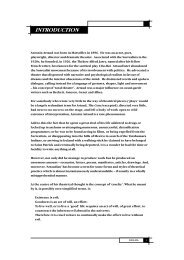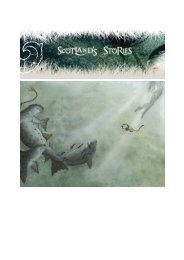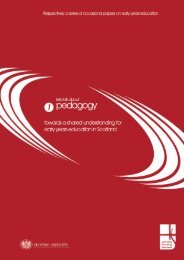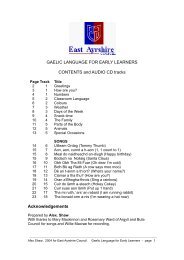Bertolt Brecht - Education Scotland
Bertolt Brecht - Education Scotland
Bertolt Brecht - Education Scotland
You also want an ePaper? Increase the reach of your titles
YUMPU automatically turns print PDFs into web optimized ePapers that Google loves.
36<br />
CRITICAL STUDIES<br />
Stevenson, R, and Wallace, G (eds.), Scottish Theatre Since the Seventies,<br />
Edinburgh: Edinburgh University Press, 1996<br />
Olga Taxidou’s ‘Epic Theatre in <strong>Scotland</strong>’ is clearly the most obvious choice of<br />
reading from this wide-ranging book: there are other moments with<br />
interesting passages concerning <strong>Brecht</strong> in <strong>Scotland</strong>.<br />
Styan, J L, Modern Drama in Theory and Practice: Volume 3. Expressionism<br />
and Epic Theatre, Cambridge: Cambridge University Press, 1983<br />
Last of a three-part survey of modern theatre that is as lucid and engaging as<br />
the other two volumes. Highly recommended.<br />
Thomson, P (with a conclusion by Gardner, V), Mother Courage and Her<br />
Children, Cambridge: Cambridge University Press, 1997<br />
A whole study devoted to the production history of a single play. Outstanding.<br />
Thoss, M, <strong>Brecht</strong> for Beginners, London: Writers and Readers Ltd, 1994<br />
This is <strong>Brecht</strong>’s entire life and work drawn as a comic book, with text, line<br />
drawings and photographs. It is highly entertaining but the title ‘for<br />
Beginners’ is extremely misleading.<br />
Völker, K, <strong>Brecht</strong>: A Biography, trans. Nowell, J, London: Marion Boyars, 1979<br />
Charts <strong>Brecht</strong>’s early development and influences – Rimbaud, Wedekind,<br />
Shakespeare, Kipling, and others – his long association with Caspar Neher and<br />
his penchant for collaboration.<br />
A chapter on Baal (pp44–50) also looks at <strong>Brecht</strong>’s perpetual revisions of the<br />
play over the years, due mostly to the fact that it was originally written before<br />
he became a Marxist and later <strong>Brecht</strong> wanted to introduce elements of his<br />
Marxist beliefs into the play.<br />
An analysis of In The Jungle of the Cities (pp75–83) deals with <strong>Brecht</strong>’s use of<br />
Chicago as a distancing effect, to be used in later years, most particularly in<br />
Arturo Ui (the collaboration of Margarete Steffin on Ui is dealt with on p271).<br />
Volker also looks at Man is Man (pp118–124), Round Heads and Pointed<br />
Heads (pp227–229) – which Völker believes to be a much neglected parable –<br />
and the debt <strong>Brecht</strong> owed to Shakespeare’s Measure for Measure.<br />
There is a great series of twenty-four photographs of the didactic play What is<br />
the Price of Iron? that clearly emphasise its anti-naturalist staging and design,<br />
its early Epic techniques and <strong>Brecht</strong>’s collaboration with Ruth Berlau.<br />
Völker goes on to look at Saint Joan of the Stockyards (yet again set in<br />
Chicago) on pp152–159; Elisabeth Hauptmann’s collaboration, its drawing on<br />
his earlier In the Jungle of the Cities and the influence of Shakespeare on this<br />
play. Herr Puntila and his Servant Matti is considered on pp273–281.<br />
DRAMA



